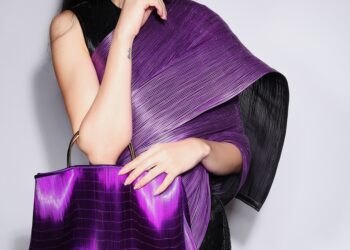BY RUKMA SALUJA
Don’t buy new, don’t throw. Re-use creatively. Upcycle!
It all boils down to the same thing whichever way you look at it. We have to think of our planet, our home. Use and throw has not been healthy for our planet’s health. Throw becomes a problem when the earth cannot absorb the waste anymore. She is falling ill and her symptoms are many: wildfires, floods, pandemics, unheard-of snow in the tropics and soaring temperatures in cold parts of the hemisphere.
Put your best foot forward, we are told; look good, first impressions matter. We all love fashion and so we turn to our wardrobes. The poor fashion industry, inevitably, becomes the focus of such discussions. It is here, we the wearers, and they the designers, can make a difference. We with our enormous appetites for the new and the latest, and they the designers with an acute aesthetic and visual sense can turn around the old into the new, to upcycle. Clothes that are last season, or don’t fit or are torn can be refashioned, refurbished.

Haven’t we of a certain vintage done this already, when we wore hand-me-downs from older siblings after Mom had worked her magic to make them look new? Those were socialist times until then PM P.V. Narasimha Rao and then Finance Minister Manmohan Singh, who later went on to become prime minister, put their heads together and opened up the economy, putting it firmly on the path to consumerism. Indians post that decision grew up seeing shop shelves burgeoning with produce, endless choices and abundance. All very good, India rising, India shining and all that until recently when a young person told me: I change my wardrobe every three months. I do hope the utter disgust I felt didn’t show on my face. But there you have it. The very reason we need to slow it down. Make it new again. Upcycle.
Upcycling is a great way forward for these super spenders; others might perhaps need less persuasion. Another way is to wear to last rather than wear and throw. Didn’t the pandemic and lockdowns show us just how much we have and how little we need? Delhi-based Sharad Sharma of Beejoliyo, who has rebranded to focus from occasionwear to streetwear, says, “I have abused the industry and want to give back now.” To that end he uses polythene bags as threadwork on plant-based garments, as piping, and as buttons. “I try to use plastic so that it doesn’t get thrown back to lie around. We use organic fabric, embellish with embroidery and patch it on the fabric. We try to stop it from lying around as it does not really bio degrade. People are amazed and can’t really tell it is embroidery from polybags. That is the USP of my brand.”
Toronto-based Tara Bhuyan whose Tara Bhuyan Couture sells globally, says, “Fashion, without a doubt, is doing all of these things, not only to reduce waste, but also tocontribute to a greener, more environment friendly world. In fact, Tara Bhuyan Couture has been upcycling garments since 2019. We give new life to a lot of vintage clothing by upcycling it into a useful and valued product.”

Delhi-based Gautam Gupta of Asha Gautam echoes the thought: “The fashion industry is taking a turn toward sustainability in baby steps. While terms such as upcycling, downcycling and recycling might be jargon to some, many in this industry are now realising the importance of these practices and are putting them into use wherever possible.”
There is a certain vision that is a part of some brands. Each of Beejoliyo’s collections, for instance, has an element of the 3Rs (reduce, reuse, recycle). “We cannot change the quality of the polythene,” Sharma says. “We cannot make a new material out of what would need huge machines and massive investment. We upscale by using it again and making it look good. We upcycle the garment and not the polythene. You have to understand that very clearly. My job is to create garments, not create polythene.”

There is a sense that these sorts of initiatives err on the side of activism, that upcycled garments might never become red carpet wear. Bhuyan disagrees, “Upcycling has the potential to be upmarket, trendy and creative,” she says. “The goal of incorporating upcycling into the fashion industry is to do precisely that and, of course, eliminate waste and increase resource efficiency.”
The good news is, quite a few brands are looking at upcycling waste material to make new designs and recycling discarded materials to create something brand new. “Yes, it is also true that several fashion houses use this jargon as a marketing ploy. However, with the impending environmental crisis this generation is facing there is a gradual shift towards sustainability”, says, Shuli Ghosh, co-founder and creative director, Sienna Store & Café, a part of Baro Market, Mumbai.
Gupta has little doubt that it is the way forward and can be hip and fashionable. “Upcycling can look trendy, stylish and chic if the design intervention is smart and aesthetically pleasing,” he says. “It can also achieve the look of haute couture with a detailed understanding of how to reuse the old piece. The time is not far when upcycled garments would have a large possibility of showing up at red carpet events.”
Tiny steps that could soon become the norm.
@ashagautam @tarabhuyancouture @sharadsharma @roopasandhir








